|
With the opening of The History of Cremation Exhibit at the National Museum of Funeral History (and the holidays making us a bit introspective and nostalgic), we’ve had a renewed sense of interest in the history of the cremation movement—and therefore the history of the Cremation Association. And we thought we’d take the time to celebrate some of the establishments that had representatives at the first convention in Detroit in 1913 remain part of CANA today. (While not all have maintained continuous membership for all of the association’s 105-year existence, their memberships are current now, at a time when cremation education and information are in high demand.) In early 1913, Dr. Hugo Erichsen sent invitations to every crematory in existence, and even to some strong advocates who were not affiliated with crematories. An advertisement in Modern Cemetery Magazine “proposed to establish a national organization and discuss various questions of practical import relating to the best methods of advertising, management of crematoria, etc.” which became CANA. Erichsen’s invitation brought fourteen representatives from ten of the fifty-or-so crematories in operation at the time. Along the way, several established crematories added their names to the roster of the association and they too have given their continued support for cremation. We share seven stories of these earliest delegates, and current CANA members, below. the buffalo cremation companyBUFFALO, NEW YORK 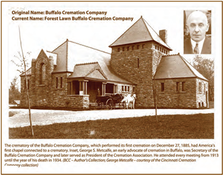 The Buffalo Cremation Company completed its “Crematory Temple” just after its first cremation took place on December 27, 1885. The engineer for the crematory came to the U.S. from Italy to oversee the construction. The temple was unlike any structure built in the U.S. at the time. In fact, it would be a couple more years before a complete cremation facility was completed at the Missouri Crematory at St. Louis. The delegate for the Buffalo Cremation Company was George Metcalfe. Endeared to many and known as “Uncle George,” Metcalfe was in attendance at all but one Cremation Association convention from its inception to his death in 1934. At present, the crematory is still in operation as the Forest Lawn Buffalo Cremation Company under Joseph Dispenza and his capable staff. the us cremation companyMIDDLE VILLAGE, NEW YORK 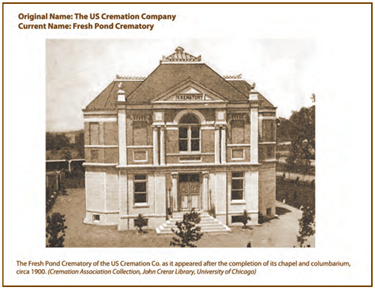 The US Cremation Company completed their more utilitarian structure housing only the cremation apparatus, and conducted their first cremation on December 4, 1885. Their membership in the association came after the first meeting, their delegate, William Berendsohn, serving as our third president from 1918-1920. The crematory is now operated as the Fresh Pond Crematory and is managed by memorialization advocate Joseph Di Troia, a second-generation operator. THE CINCINNATI CREMATION COMPANYCINCINNATI, OHIO 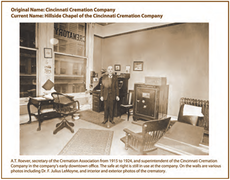 After the US Cremation Company and the Buffalo Cremation Company, the Cincinnati Cremation Company operates the third-oldest operating crematory in our country. The cremation furnace was completed and their first cremation took place June 22, 1887. Their chapel was added in 1888. Additionally, they sent a delegate to the first meeting of the Cremation Association, A.T. Roever, and, in 1915, he was elected Secretary – a post he held for almost a decade. Later, R. Herbert Heil operated the Cincinnati Cremation Company, and served as president of the Cremation Association from 1947-1949. Today, the Catchen family own and operate the crematory and columbarium as the Hillside Chapel of the Cincinnati Cremation Company. CREMATORIUM, LIMITEDOUTREMONT, QUÉBEC In Canada, the first crematory in operation was the Crematorium, Limited, operated on the grounds of the Mount Royal Cemetery in Montreal, Quebec. Construction on the crematory here was begun in 1900, and it completed its first cremation in 1901. Their delegate to the first Cremation Association meeting was W. Ormiston Roy, who was the first to confirm his attendance after Dr. Erichsen’s invitation to the 1913 meeting in Detroit. He served as our president from 1920-1922. Mount Royal Cemetery has now assumed control of Crematorium, Inc.’s operations, and it is still a sought-after and popular cremation services provider. FLANNER & BUCHANANINDIANAPOLIS, INDIANA 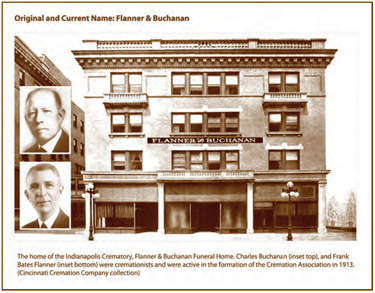 In 1904, the leading Indianapolis undertaking firm Flanner & Buchanan decided their establishment was incomplete without the appropriate facilities for serving families who desired cremation. The nearest crematories were more than 100 miles away, and at least one of the active members of their ownership, Charles Buchanan, was a cremationist. At the time, their firm was one of just a handful of funeral directors that owned a crematory. They became active in the Cremation Association, Charles Buchanan being present at the first meeting, then serving as president from 1922-1925. Additionally, Frank Bates Flanner, while not an officer of the Cremation Association, made many presentations at conventions and wrote many informational pamphlets for better relations between funeral directors and crematories, which had been an antagonistic relationship even in those early days. While the original building and even the second building have long been razed, Flanner Buchanan is still thriving as a leading funeral services provider in Indianapolis and surrounding areas. FRESNO CREMATORYFRESNO, CALIFORNIA 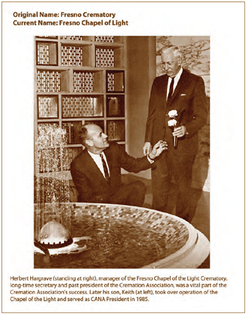 Fresno’s Chapel of the Light, established in 1914 as the Fresno Crematory, was begun by a reform society of cremationists in their city. After struggling with their ability to successfully operate a crematory, the trustees of the crematory approached Lawrence Moore, operator of the California Crematorium in Oakland, to take over their operations. He purchased a majority of the stock and became the owner in 1919. On what was to be a brief assignment, Moore sent one of his employees, Herbert Hargrave, to operate the facility. He ended up staying in Fresno and quickly became involved in the Cremation Association. In 1925, he was elected Secretary and maintained that position until his retirement in 1979, with the exception of a two-year term as president from 1935-1937. He operated the Chapel of the Light from his initial assignment there until his death in 1981. Herbert Hargrave’s son, Keith, worked with his father at the Chapel of the Light, serving his Cremation Association presidency from 1985-1986. He became involved in the crematory’s operations in 1955, assuming management responsibilities at his father’s retirement. He served as General Manager throughout acquisitions and the selling of the firm and was a mainstay in the company until his death in 2014. VALHALLA CREMATORYST. LOUIS, MISSOURI The second crematory constructed in St. Louis was completed in 1919 by the St. Louis Mausoleum and Crematory Company, a division of the National Securities Company in St. Louis, and on the grounds of the Valhalla Cemetery on St. Charles Rock Road. Their involvement in the Cremation Association was begun by Robert J. Guthrie, who served as treasurer of the Association from 1925-1932 when he was elected president. Just two years later his death ushered in a new branch of his family. Having no children of his own, Guthrie left the operations of the Valhalla Chapel to his niece’s husband, Mr. Clifford F. Zell, Sr. The Zell family have been some of the most influential cremationists in American history. Their facility in St. Louis was a blending of the east and west coast ideas of cremation and inurnment. In addition to Mr. Guthrie, their family produced three past-presidents of the Cremation Association, Cliff Zell, Sr., Cliff Zell, Jr., and the first-ever female president of any funeral service or cemetery organization, Genevieve “Jinger” Zell, wife of Cliff Zell, Jr. Valhalla is still under the operation of the Zell family. It would take pages upon pages to list the crematories in the country and their respective individuals that have been active in our Association since our beginning in 1913. Suffice it to say that all have served in countless capacities—from leading the association as officers and board members to faithfully paying dues each year—and each have contributed in their own ways to the growth and success of our association and of the cremation movement in North America. Past, present, and future, our association’s membership continues to be the guiding force of cremation in America. This post is excerpted from an article of the same name originally published in The Cremationist Volume 52, Issue 1. Since then, we’ve celebrated our 100th Convention, our 105th Anniversary, and the opening of the first History of Cremation Exhibit at the National Museum of Funeral History. It’s been a busy two years and we’re grateful for the continued leadership and support of our members both old and new. Thank you for all you do for the association, the profession, and your communities – it just wouldn’t be the same without you.
Happy Holidays from CANA. How to Donate to the History of Cremation Exhibit Financial or artifact contributions are what make the History of Cremation Exhibit possible. Please consider donating to the History of Cremation Exhibit today.
In today’s world, talk about going completely online is a topic for most businesses. The preneed industry is no different. Our consumers, as with any others, like to do research and shop online, so providing them an avenue to do this is very important. Providing options and allowing customers to shop and truly plan out their funeral is what they are looking for. 1. Offer a range of optionsIn some cases, an online contact will lead to a cremation sale with very few additions, very simple and straightforward. In other cases you’ll need to provide avenues to shop for a range of items, including caskets, other merchandise, and services. In all cases you need to be prepared to serve each customer differently and provide them with the options they want so they can shop and do it on their own time. Make their online experience similar to what you provide in person. Make it easy and engaging for them to interact with you. 2. capturing personal dataAnother key component is to continually monitor who is visiting your sites and capturing their information to ensure you can follow up. Planning and purchasing funeral services online may be difficult for some consumers, so establishing those relationships and providing ways for families to contact you if they have questions will be key to finalizing the purchase. These consumers may even opt to come and meet with you after planning most of their funeral online, because they just can’t or won’t finalize arrangements online. Be ready for this type of consumer. They will be very prepared to tell you what they want and will be looking for your help to finalize their plans. We are finding that the younger demographics, people under 40, are using “Contact Us” forms as a first contact. They include messages like: “I’m interested in pre planning. Please call me,” or “My uncle just died. I need some information. Please call me.” These consumers are more likely to send an email than make a phone call, so make sure your “Contact Us” form is on your home page or easily available on the main navigation pages. 3. Consumers want to see pricesPricing is important to these online shoppers, so please don’t leave it out. If families don’t find pricing on your website within two clicks, they will leave and find another funeral home. We do know that mobile is used more than desktop searches, so be sure to pull out your phone and count the number of clicks it takes for a person to find your pricing. If you don’t have pricing on your website and you’re not sure if you should add it, check your website analytics report. This will tell you where consumers are going on your website. The standard is #1 - Obituaries, #2 - Contact, #3 - Pricing. If you have a high bounce rate—over 50%—on your pricing page, then this tells you consumers are leaving. 4. MARKETING ONLINE SERVICESMarketing your online services should be no different than what you do to market your funeral home services currently. Let consumers know that they can shop and browse their options online in your direct mail campaigns, at your group presentations, in your advertising, and on your social media pages. Online shopping should fit into all of your current marketing efforts and be presented as an additional service and option you provide. Perhaps you even lead with your online shopping options in your marketing so that people know they can plan in their own time and you are ready for them when they are ready. 5. Get creative with videoPeople don’t read like they used to. Just look at your social media accounts. Compare video to text and you’ll find that posts are going to be 5 to 1, with more and more video being added all the time. A great tool you can use is an “explainer video.” These can be in the form of animation or with still photos, telling more about your product or services. Online preneed sales may not be for everyone but providing the option to everyone will ensure that you are getting those sales from people who are ready to buy online. This doesn’t mean that you have to sacrifice your great service. It just means you are offering them a way to plan in their own time. You can still provide your great service on the website, after the sale, and while the policy is in force. This article originally appeared in The Cremationist, Vol 54, Issue 1 by the same name. Are you looking for more about creating a preneed strategy that makes a difference? The Art of Selling Cremation: A Preneed Summit is back for the second year to with a one-day intensive on today's pressing preneed topics. Join colleagues in Las Vegas on February 5th, 2019 – see the full schedule at www.cremationassociation.org/CANAheroes.
|
The Cremation Logs Blog
Cremation experts share the latest news, trends, and creative advice for industry professionals. Register or log in to subscribe and stay engaged with all things cremation. Categories
All
Archives
July 2024
|
|
